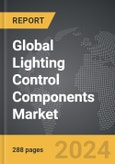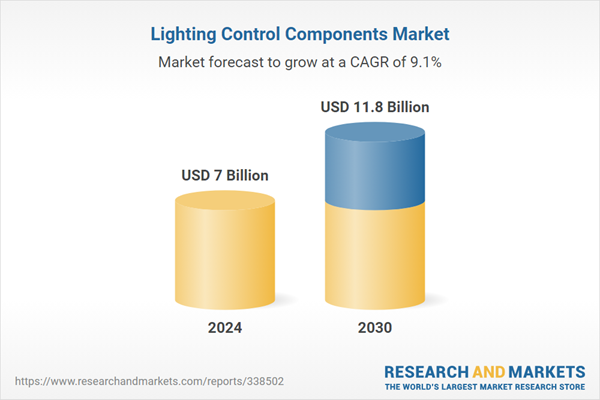The global market for Lighting Control Components was valued at US$7.0 Billion in 2024 and is projected to reach US$11.8 Billion by 2030, growing at a CAGR of 9.1% from 2024 to 2030. This comprehensive report provides an in-depth analysis of market trends, drivers, and forecasts, helping you make informed business decisions. The report includes the most recent global tariff developments and how they impact the Lighting Control Components market.
Segments: End-Use (Corporate, Retail, Outdoor, Residential, Other End-Uses).
Geographic Regions/Countries: World; United States; Canada; Japan; China; Europe (France; Germany; Italy; United Kingdom; Spain; Russia; and Rest of Europe); Asia-Pacific (Australia; India; South Korea; and Rest of Asia-Pacific); Latin America (Argentina; Brazil; Mexico; and Rest of Latin America); Middle East (Iran; Israel; Saudi Arabia; United Arab Emirates; and Rest of Middle East); and Africa.
The analysts continuously track trade developments worldwide, drawing insights from leading global economists and over 200 industry and policy institutions, including think tanks, trade organizations, and national economic advisory bodies. This intelligence is integrated into forecasting models to provide timely, data-driven analysis of emerging risks and opportunities.
Global Lighting Control Components Market - Key Trends and Drivers Summarized
What Are The Core Components Of Lighting Control Systems?
Lighting control systems are composed of several essential components that work together to manage lighting efficiently. At the heart of these systems are controllers, which serve as the brain of the operation. Controllers can be simple, such as dimmers or timers, or complex, such as programmable logic controllers (PLCs) that manage multiple lighting zones. Sensors play a critical role, detecting occupancy, daylight levels, or other environmental factors to adjust lighting automatically. These sensors can include motion detectors, light sensors, and even advanced cameras for more precise control. Additionally, user interfaces, such as wall switches, touch panels, or mobile apps, allow users to manually adjust lighting settings. Finally, communication protocols, such as DALI, Zigbee, or Bluetooth, enable the various components to communicate seamlessly, ensuring that the system operates smoothly and efficiently.How Do Advanced Technologies Transform Lighting Controls?
The integration of advanced technologies has revolutionized lighting control components, bringing unprecedented levels of efficiency and flexibility. Smart lighting systems, powered by the Internet of Things (IoT), enable remote control and automation through internet connectivity. This allows users to adjust lighting settings from anywhere, at any time, using smartphones or computers. Artificial intelligence (AI) and machine learning (ML) further enhance these systems by enabling predictive lighting adjustments based on historical data and usage patterns. This means that lighting can adapt dynamically to changes in occupancy or ambient light conditions, optimizing energy usage and enhancing user comfort. Moreover, the incorporation of wireless technologies, such as Wi-Fi and Zigbee, has eliminated the need for extensive wiring, reducing installation costs and complexity. These technological advancements are driving the adoption of smart lighting solutions across residential, commercial, and industrial sectors.Why Is Integration With Building Management Systems (BMS) Crucial?
The integration of lighting control components with Building Management Systems (BMS) is becoming increasingly important for achieving holistic building automation. BMS are centralized systems that monitor and control various building operations, including HVAC, security, and lighting. By integrating lighting controls with BMS, facility managers can achieve greater energy efficiency and operational efficiency. This integration allows for coordinated responses to changing building conditions; for example, adjusting lighting in response to HVAC settings to optimize overall energy consumption. Furthermore, it enables centralized monitoring and control, providing real-time data on lighting performance and usage. This data can be used to identify patterns, predict maintenance needs, and implement energy-saving strategies. Additionally, the integration supports compliance with building codes and standards, which increasingly mandate the use of energy-efficient lighting solutions.What Drives The Growth In The Lighting Control Market?
The growth in the lighting control market is driven by several factors. Technological advancements, such as the development of IoT-enabled smart lighting systems, are a significant driver, offering enhanced functionality and user convenience. The increasing focus on energy efficiency and sustainability, driven by stringent government regulations and rising energy costs, is also propelling market growth. Consumers are becoming more environmentally conscious and are seeking solutions that reduce energy consumption and carbon footprints. Moreover, the rising adoption of smart homes and buildings, fueled by urbanization and the growing trend of home automation, is boosting demand for advanced lighting controls. Additionally, the commercial sector's need for flexible and efficient lighting solutions, particularly in office spaces and retail environments, is contributing to market expansion. These factors, combined with advancements in wireless communication technologies and the decreasing cost of smart lighting components, are creating a favorable environment for the proliferation of lighting control systems.Report Scope
The report analyzes the Lighting Control Components market, presented in terms of units. The analysis covers the key segments and geographic regions outlined below.Segments: End-Use (Corporate, Retail, Outdoor, Residential, Other End-Uses).
Geographic Regions/Countries: World; United States; Canada; Japan; China; Europe (France; Germany; Italy; United Kingdom; Spain; Russia; and Rest of Europe); Asia-Pacific (Australia; India; South Korea; and Rest of Asia-Pacific); Latin America (Argentina; Brazil; Mexico; and Rest of Latin America); Middle East (Iran; Israel; Saudi Arabia; United Arab Emirates; and Rest of Middle East); and Africa.
Key Insights:
- Market Growth: Understand the significant growth trajectory of the Corporate End-Use segment, which is expected to reach US$4.4 Billion by 2030 with a CAGR of a 6.6%. The Retail End-Use segment is also set to grow at 10.1% CAGR over the analysis period.
- Regional Analysis: Gain insights into the U.S. market, valued at $1.9 Billion in 2024, and China, forecasted to grow at an impressive 12.8% CAGR to reach $2.5 Billion by 2030. Discover growth trends in other key regions, including Japan, Canada, Germany, and the Asia-Pacific.
Why You Should Buy This Report:
- Detailed Market Analysis: Access a thorough analysis of the Global Lighting Control Components Market, covering all major geographic regions and market segments.
- Competitive Insights: Get an overview of the competitive landscape, including the market presence of major players across different geographies.
- Future Trends and Drivers: Understand the key trends and drivers shaping the future of the Global Lighting Control Components Market.
- Actionable Insights: Benefit from actionable insights that can help you identify new revenue opportunities and make strategic business decisions.
Key Questions Answered:
- How is the Global Lighting Control Components Market expected to evolve by 2030?
- What are the main drivers and restraints affecting the market?
- Which market segments will grow the most over the forecast period?
- How will market shares for different regions and segments change by 2030?
- Who are the leading players in the market, and what are their prospects?
Report Features:
- Comprehensive Market Data: Independent analysis of annual sales and market forecasts in US$ Million from 2024 to 2030.
- In-Depth Regional Analysis: Detailed insights into key markets, including the U.S., China, Japan, Canada, Europe, Asia-Pacific, Latin America, Middle East, and Africa.
- Company Profiles: Coverage of players such as Acuity Brands Lighting Inc., Cree, Inc., Current, Powered by GE, Eaton Corp., Fagerhults Belysning AB and more.
- Complimentary Updates: Receive free report updates for one year to keep you informed of the latest market developments.
Some of the 232 companies featured in this Lighting Control Components market report include:
- Acuity Brands Lighting Inc.
- Cree, Inc.
- Current, Powered by GE
- Eaton Corp.
- Fagerhults Belysning AB
- FW Thorpe Plc
- Hubbell Control Solutions (HCS)
- Legrand S.A.
- Leviton Manufacturing Co., Inc.
- LG Innotek
- Lutron Electronics, Inc.
- Osram GmbH
- Panasonic Corp.
- Schneider Electric SA
- TCP International Holdings Ltd.
- Theben AG
- Zumtobel Group AG
Tariff Impact Analysis: Key Insights for 2025
Global tariff negotiations across 180+ countries are reshaping supply chains, costs, and competitiveness. This report reflects the latest developments as of April 2025 and incorporates forward-looking insights into the market outlook.The analysts continuously track trade developments worldwide, drawing insights from leading global economists and over 200 industry and policy institutions, including think tanks, trade organizations, and national economic advisory bodies. This intelligence is integrated into forecasting models to provide timely, data-driven analysis of emerging risks and opportunities.
What’s Included in This Edition:
- Tariff-adjusted market forecasts by region and segment
- Analysis of cost and supply chain implications by sourcing and trade exposure
- Strategic insights into geographic shifts
Buyers receive a free July 2025 update with:
- Finalized tariff impacts and new trade agreement effects
- Updated projections reflecting global sourcing and cost shifts
- Expanded country-specific coverage across the industry
Table of Contents
I. METHODOLOGYII. EXECUTIVE SUMMARY2. FOCUS ON SELECT PLAYERSIII. MARKET ANALYSISSOUTH KOREAREST OF ASIA-PACIFICARGENTINABRAZILMEXICOREST OF LATIN AMERICAIRANISRAELSAUDI ARABIAUNITED ARAB EMIRATESREST OF MIDDLE EASTIV. COMPETITION
1. MARKET OVERVIEW
3. MARKET TRENDS & DRIVERS
4. GLOBAL MARKET PERSPECTIVE
UNITED STATES
CANADA
JAPAN
CHINA
EUROPE
FRANCE
GERMANY
ITALY
UNITED KINGDOM
SPAIN
RUSSIA
REST OF EUROPE
ASIA-PACIFIC
AUSTRALIA
INDIA
LATIN AMERICA
MIDDLE EAST
AFRICA
Companies Mentioned (Partial List)
A selection of companies mentioned in this report includes, but is not limited to:
- Acuity Brands Lighting Inc.
- Cree, Inc.
- Current, Powered by GE
- Eaton Corp.
- Fagerhults Belysning AB
- FW Thorpe Plc
- Hubbell Control Solutions (HCS)
- Legrand S.A.
- Leviton Manufacturing Co., Inc.
- LG Innotek
- Lutron Electronics, Inc.
- Osram GmbH
- Panasonic Corp.
- Schneider Electric SA
- TCP International Holdings Ltd.
- Theben AG
- Zumtobel Group AG
Table Information
| Report Attribute | Details |
|---|---|
| No. of Pages | 288 |
| Published | April 2025 |
| Forecast Period | 2024 - 2030 |
| Estimated Market Value ( USD | $ 7 Billion |
| Forecasted Market Value ( USD | $ 11.8 Billion |
| Compound Annual Growth Rate | 9.1% |
| Regions Covered | Global |









